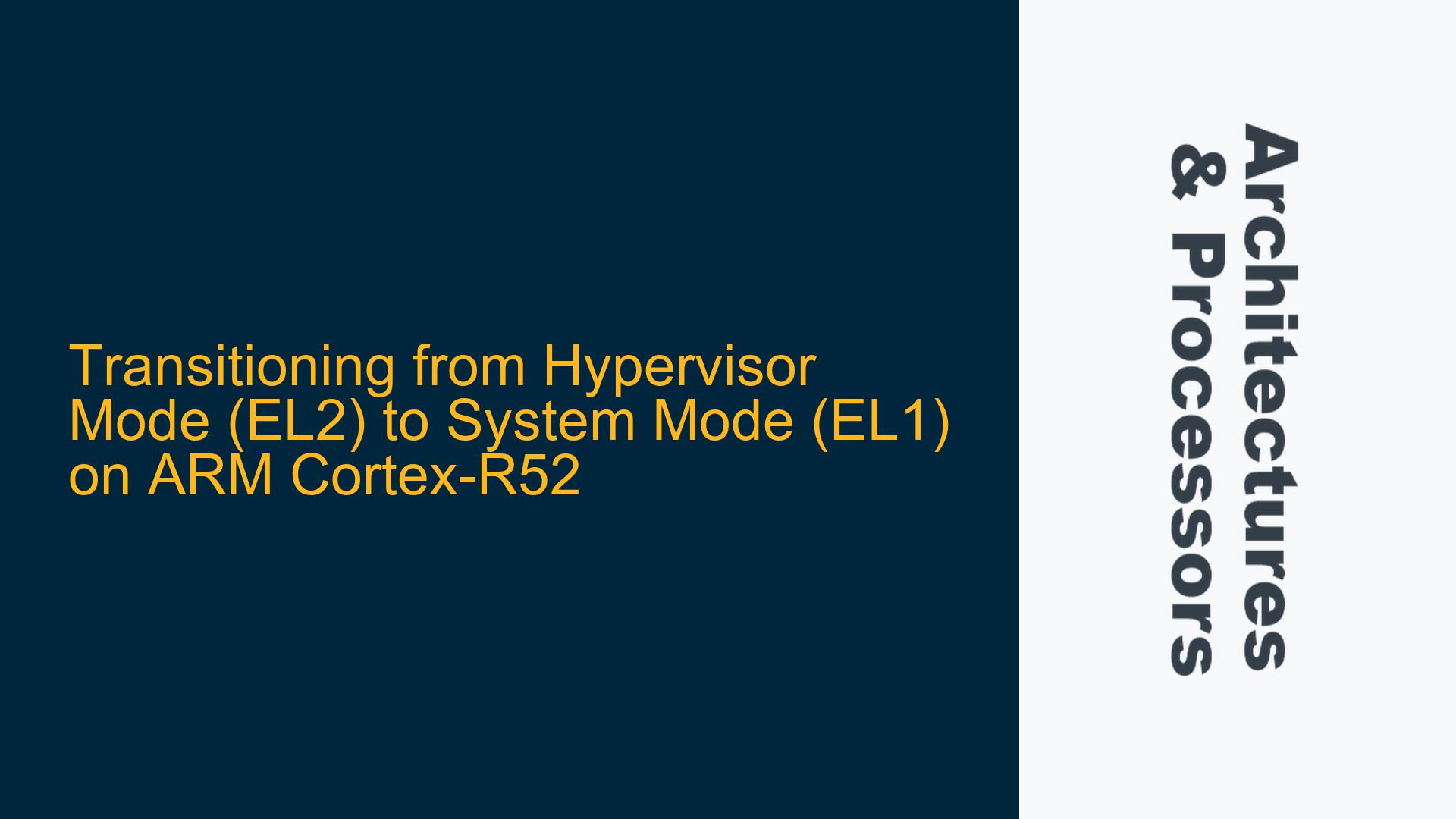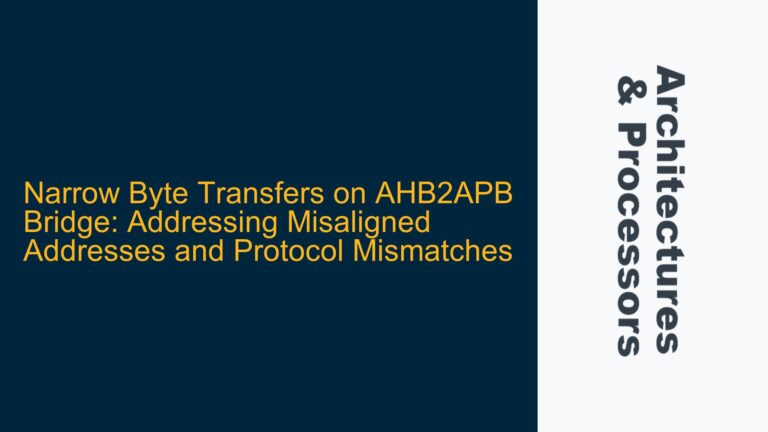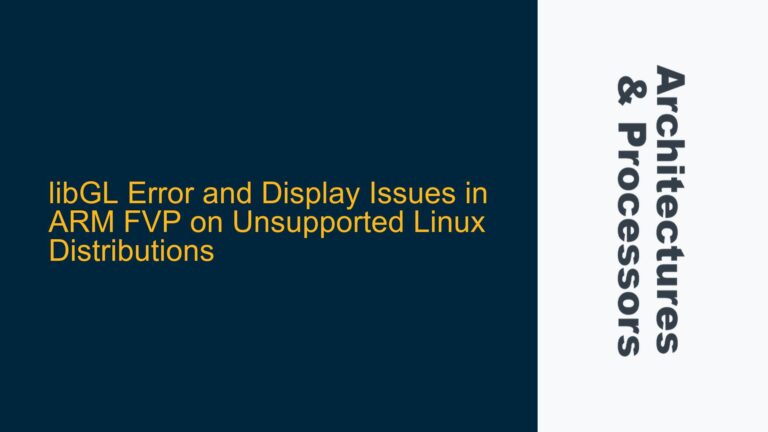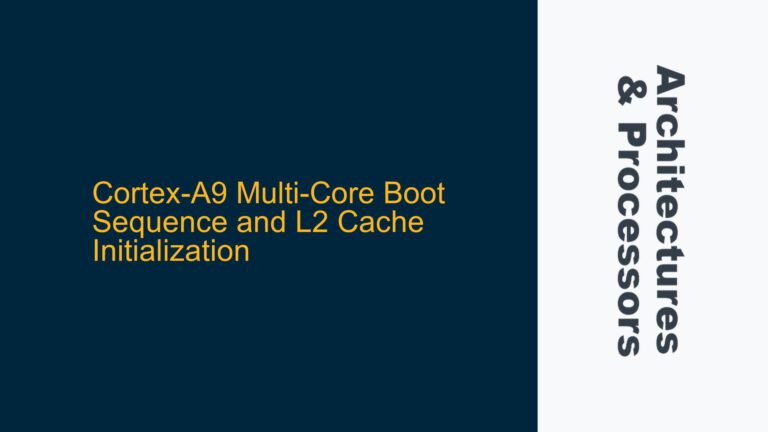Hypervisor Mode to System Mode Transition Requirements on ARM Cortex-R52
The ARM Cortex-R52 processor, part of the ARMv8-R architecture, supports multiple exception levels (ELs) to provide a hierarchical privilege model. Exception Level 2 (EL2), also known as Hypervisor Mode, is typically used for virtualization, while Exception Level 1 (EL1), or System Mode, is used for operating system kernels. Transitioning from EL2 to EL1 is a critical operation that requires careful handling of the processor state, register configurations, and exception handling mechanisms. This transition is not as straightforward as a simple mode switch due to the architectural differences between EL2 and EL1, including the handling of virtual memory, system registers, and interrupt configurations.
The ARM Cortex-R52 processor does not provide a direct instruction to switch from EL2 to EL1. Instead, the transition must be orchestrated through a combination of register manipulations and exception handling. The key challenge lies in ensuring that the processor state is correctly configured for EL1 operation, including the setup of the appropriate stack pointers, system registers, and memory management units (MMUs). Additionally, the transition must account for any pending exceptions or interrupts that could disrupt the process.
Architectural Constraints and State Management During EL2 to EL1 Transition
The transition from EL2 to EL1 on the ARM Cortex-R52 is constrained by several architectural factors. First, the processor must ensure that all pending exceptions and interrupts are handled or masked before the transition. This is because the exception handling mechanisms differ between EL2 and EL1, and an unhandled exception during the transition could lead to unpredictable behavior. Second, the processor state, including the general-purpose registers, system registers, and program status registers, must be saved and restored appropriately. This is particularly important for registers that are banked between exception levels, such as the Stack Pointer (SP) and the Link Register (LR).
Another critical consideration is the configuration of the MMU and the translation tables. EL2 typically uses a different set of translation tables than EL1, and these tables must be reconfigured during the transition. Failure to do so could result in memory access violations or incorrect address translations. Additionally, the ARM Cortex-R52 supports virtualization extensions, which may require the hypervisor to save and restore the state of virtual machines (VMs) before transitioning to EL1.
The Secure State is another factor that must be considered. The ARM Cortex-R52 supports both Secure and Non-secure states, and the transition from EL2 to EL1 may involve a change in the security state. This requires careful handling of the Secure Configuration Register (SCR) and other security-related registers.
Implementing the EL2 to EL1 Transition with Exception Handling and Register Configuration
To implement the transition from EL2 to EL1 on the ARM Cortex-R52, the following steps must be taken:
-
Save the Current Processor State: Before initiating the transition, the current state of the processor must be saved. This includes the general-purpose registers, system registers, and program status registers. The state can be saved to memory or to a reserved set of registers.
-
Configure the EL1 Stack Pointer: The Stack Pointer (SP) for EL1 must be configured before the transition. This involves setting the SP_EL1 register to point to the appropriate memory location for the EL1 stack.
-
Reconfigure the MMU and Translation Tables: The MMU and translation tables must be reconfigured for EL1 operation. This involves updating the Translation Table Base Registers (TTBRs) and the Memory System Control Registers (SCTLRs) to reflect the EL1 configuration.
-
Mask Interrupts and Exceptions: All interrupts and exceptions must be masked or handled before the transition. This can be done by setting the appropriate bits in the Interrupt Mask Register (IMR) and the Exception Mask Register (EMR).
-
Set the Exception Return Address: The Exception Return Address (ELR_EL2) must be set to the address of the code that will execute in EL1 after the transition. This is typically done using the
ERETinstruction. -
Switch to EL1: The transition to EL1 is initiated by executing the
ERETinstruction. This instruction causes the processor to switch to EL1 and begin executing the code at the address specified in the ELR_EL2 register. -
Restore the Processor State: After the transition, the processor state must be restored from the saved state. This includes restoring the general-purpose registers, system registers, and program status registers.
-
Re-enable Interrupts and Exceptions: Once the transition is complete, interrupts and exceptions can be re-enabled by clearing the appropriate bits in the Interrupt Mask Register (IMR) and the Exception Mask Register (EMR).
The following table summarizes the key registers and their roles in the EL2 to EL1 transition:
| Register | Role in Transition |
|---|---|
| SP_EL1 | Stack Pointer for EL1, must be configured before transition |
| TTBR0_EL1 | Translation Table Base Register for EL1, must be updated for EL1 memory management |
| SCTLR_EL1 | System Control Register for EL1, controls MMU and cache behavior |
| ELR_EL2 | Exception Return Address, holds the address to return to after transition |
| IMR | Interrupt Mask Register, used to mask interrupts during transition |
| EMR | Exception Mask Register, used to mask exceptions during transition |
| SCR | Secure Configuration Register, controls security state during transition |
Detailed Steps for Implementing the Transition
-
Save the Current Processor State: The first step in the transition process is to save the current state of the processor. This includes saving the general-purpose registers (R0-R12), the Stack Pointer (SP), the Link Register (LR), and the Program Counter (PC). The state can be saved to a reserved area of memory or to a set of registers that are not used during the transition. This step is crucial to ensure that the processor can resume execution in EL1 without losing any critical state information.
-
Configure the EL1 Stack Pointer: The Stack Pointer for EL1 (SP_EL1) must be configured before the transition. This involves setting the SP_EL1 register to point to the appropriate memory location for the EL1 stack. The stack is used for storing temporary data and for managing function calls in EL1. The stack pointer must be set to a valid memory address that is accessible in EL1.
-
Reconfigure the MMU and Translation Tables: The Memory Management Unit (MMU) and translation tables must be reconfigured for EL1 operation. This involves updating the Translation Table Base Registers (TTBR0_EL1 and TTBR1_EL1) to point to the translation tables that are used in EL1. The translation tables define the memory map for EL1, including the mapping of virtual addresses to physical addresses. The System Control Register (SCTLR_EL1) must also be updated to enable the MMU and configure its behavior in EL1.
-
Mask Interrupts and Exceptions: Before transitioning to EL1, all interrupts and exceptions must be masked or handled. This is done by setting the appropriate bits in the Interrupt Mask Register (IMR) and the Exception Mask Register (EMR). Masking interrupts and exceptions ensures that the transition process is not interrupted by external events. This step is critical to prevent any unexpected behavior during the transition.
-
Set the Exception Return Address: The Exception Return Address (ELR_EL2) must be set to the address of the code that will execute in EL1 after the transition. This address is typically the entry point of the EL1 code. The ELR_EL2 register is used by the
ERETinstruction to determine where to resume execution after the transition. The address must be a valid address in EL1 and must point to executable code. -
Switch to EL1: The transition to EL1 is initiated by executing the
ERETinstruction. This instruction causes the processor to switch to EL1 and begin executing the code at the address specified in the ELR_EL2 register. TheERETinstruction also restores the Program Status Register (PSR) from the Saved Program Status Register (SPSR_EL2), which contains the state of the processor before the transition. This step is the final step in the transition process and must be executed with care to ensure that the processor enters EL1 correctly. -
Restore the Processor State: After the transition to EL1, the processor state must be restored from the saved state. This includes restoring the general-purpose registers (R0-R12), the Stack Pointer (SP), the Link Register (LR), and the Program Counter (PC). The state can be restored from the memory or from the reserved set of registers where it was saved. This step ensures that the processor can resume execution in EL1 with the same state as before the transition.
-
Re-enable Interrupts and Exceptions: Once the transition to EL1 is complete, interrupts and exceptions can be re-enabled by clearing the appropriate bits in the Interrupt Mask Register (IMR) and the Exception Mask Register (EMR). This step allows the processor to handle interrupts and exceptions in EL1, which is necessary for normal operation. The interrupts and exceptions must be re-enabled carefully to avoid any race conditions or unexpected behavior.
Conclusion
Transitioning from Hypervisor Mode (EL2) to System Mode (EL1) on the ARM Cortex-R52 is a complex process that requires careful handling of the processor state, register configurations, and exception handling mechanisms. The transition must be orchestrated through a combination of register manipulations and exception handling, and it must account for architectural constraints such as the handling of virtual memory, system registers, and interrupt configurations. By following the detailed steps outlined in this guide, developers can ensure a smooth and reliable transition from EL2 to EL1 on the ARM Cortex-R52 processor.






